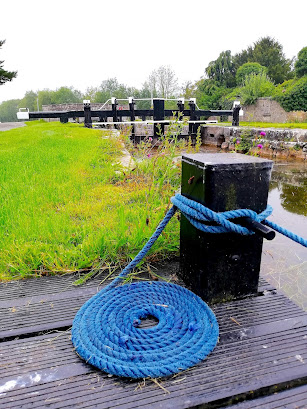Our planned trip for the day was a bit longer than we had been doing. We have been using a site which helps calculate travel times along waterways in the UK and Ireland (canalplan.uk). It told us that the trip would take five hours. With a big day ahead, we decided to try to head out early(ish) and managed to get underway before 10:30. The barge had headed out around 8:30, and we wondered if we would see him again.
The first lock was only about a mile further along. Sarah was driving and I hopped ashore, tied up and ran to get the lock ready. Once the gates were open, we pulled the boat in. I timed the whole operation, and it took about 30 minutes from start to finish.
Beyond that, we had a long level ahead of us. Just before noon, we arrived in the only village we would pass, Pollagh. We decided to have a look, and pulled up to the jetty. There was a pub (closed) and a row of charming houses along the canal.
We walked over the bridge and to the local petrol station cum shop cum cafe. The latter was closed, but we hoped to pick up some produce in the shop. Half way there, I realized that I had forgotten my mask. Sarah took the dogs and Andrea for a walk along the canal while I ran back to the boat. Sadly, the shop had very little to offer other than sliced bread, milk, soda and junk food. Well, it was a nice walk.
After Pollagh, the canal widened and we were able to make good time. When the canal is narrow, there is less room for the water to get out of our way as we move along. If we move quickly, we push up a big wave, and our stern sinks low. This slows us down, and we are more likely to hit objects on the bottom and suck up junk into the prop.
We passed along the north side of a stretch of bog land, followed by an area full of horses. By a bridge in this area we saw the WI barge tied up.
Our original plan had us going to Lock 33, to reduce the number of locks we would have the next day on the way into Shannon Harbour. When we arrived at lock 32, it was clear that our prop was really fouled again, and no amount of reverse/forward/reverse would shake it loose. So, I stripped down and went for a swim. Sure enough, I pulled lots of plastic off the prop.
When I was dry and dressed, we went to look at the water on the next level. It was clearly way down by at least 9-10 inches! The spot was the most remote we had found, and we decided to stay and enjoy the peace and quiet.
A bit later, Alan the lock keeper stopped by. He told us that the issue was with getting us into the lock on this level, as the sill for the lock gate was quite shallow. To this end, he was trying to get more water put on. If we could get into the lock, then we should be fine. Once down, he would open the water up full flow and wash us out of the lock. That didn't sound scary at all!
Alan was also a fount of knowledge about all things canal: history, geography and ecology. He poured out information at us. I tried to remember important bits as best I could.
When Alan left, we all went for a walk ahead along the canal. We could see exposed canal bed as we went. Not good! After a few turns, we saw what looked like a scene out of the Chronicles of Narnia. A huge stone table set in a niche.
Bord na Mona
Before heading out, we bought a guide book for the Grand Canal. On the maps it keeps pointing out 'Bord na Mona' bridges. The first time, I assumed it was just the name, but then I saw the same name for another bridge. What was this?Bord na Mona is the semi-governmental company set up in the 1940s to develop the turf (peat) industry to stimulate the economy in the midlands. It has since diversified into renewables, and is working towards eliminating the use of peat in power generation by 2030.











No comments:
Post a Comment